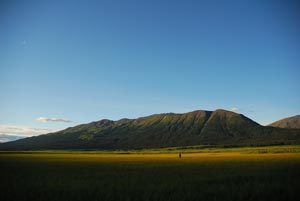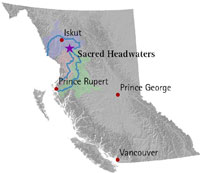
Sacred Headwaters
Encyclopedia


British Columbia
British Columbia is the westernmost of Canada's provinces and is known for its natural beauty, as reflected in its Latin motto, Splendor sine occasu . Its name was chosen by Queen Victoria in 1858...
that is the source
Source (river or stream)
The source or headwaters of a river or stream is the place from which the water in the river or stream originates.-Definition:There is no universally agreed upon definition for determining a stream's source...
of three wild salmon rivers: the Skeena River
Skeena River
The Skeena River is the second longest river entirely within British Columbia, Canada . The Skeena is an important transportation artery, particularly for the Tsimshian and the Gitxsan - whose names mean "inside the Skeena River" and "people of the Skeena River" respectively, and also during the...
, Nass River
Nass River
The Nass River is a river in northern British Columbia, Canada. It flows from the Coast Mountains southwest to Nass Bay, a sidewater of Portland Inlet, which connects to the North Pacific Ocean via the Dixon Entrance...
and Stikine River
Stikine River
The Stikine River is a river, historically also the Stickeen River, approximately 610 km long, in northwestern British Columbia in Canada and southeastern Alaska in the United States...
. It is also referred to as the Klappan Valley, although the Klappan—a tributary of the Stikine River—is only one of the area's watersheds. Local Tahltan
Tahltan
Tahltan refers to a Northern Athabaskan people who live in northern British Columbia around Telegraph Creek, Dease Lake, and Iskut.-Social Organization:...
people call the area "Klabona", which is loosely translated as "headwaters."
The area has a significant population of grizzly bear
Grizzly Bear
The grizzly bear , also known as the silvertip bear, the grizzly, or the North American brown bear, is a subspecies of brown bear that generally lives in the uplands of western North America...
s, stone sheep and caribou wolves and goat
Goat
The domestic goat is a subspecies of goat domesticated from the wild goat of southwest Asia and Eastern Europe. The goat is a member of the Bovidae family and is closely related to the sheep as both are in the goat-antelope subfamily Caprinae. There are over three hundred distinct breeds of...
s. Salmon
Salmon
Salmon is the common name for several species of fish in the family Salmonidae. Several other fish in the same family are called trout; the difference is often said to be that salmon migrate and trout are resident, but this distinction does not strictly hold true...
swim over 400 kilometres from the Pacific Ocean to spawn in the upper reaches of the river.
Industrial Development
The Sacred Headwaters is rich in mineral and energy resources, particularly coal and coalbed methaneCoalbed methane
Coalbed methane or Coal Bed Methane, coalbed gas or coal mine methane is a form of natural gas extracted from coal beds. In recent decades it has become an important source of energy in United States, Canada, and other countries...
. Several industrial development projects are planned for the area, including Fortune Minerals' open-pit Klappan Coal mine and Royal Dutch Shell
Royal Dutch Shell
Royal Dutch Shell plc , commonly known as Shell, is a global oil and gas company headquartered in The Hague, Netherlands and with its registered office in London, United Kingdom. It is the fifth-largest company in the world according to a composite measure by Forbes magazine and one of the six...
's Klappan Coalbed Methane Project
Klappan Coalbed Methane Project
The Klappan Coalbed Methane Project is a gas project owned by Shell Canada that looks to develop the coalbed methane from an area in northern British Columbia, near the source of three rivers: the Skeena River, Nass River, and Stikine River, and also the namesake Klappan River...
. Shell Canada's website reports to be conducting several environmental baseline studies being carried out within the Klappan tenure area.. The British Columbia Ministry of Energy, Mines and Petroleum Resources estimates the Klappan coal deposit could contain as much as 8.1 Tcuft of coalbed methane gas.
Klappan Coalbed Methane Project
The Klappan Coalbed Methane Project is a proposal by Shell CanadaShell Canada
Shell Canada Limited is the subsidiary of Dutch-based Royal Dutch Shell and one of Canada's largest integrated oil companies. Exploration and production of oil, natural gas and sulphur is a major part of its business, as well as the marketing of gasoline and related products through the company's...
to develop a coalbed methane
Coalbed methane
Coalbed methane or Coal Bed Methane, coalbed gas or coal mine methane is a form of natural gas extracted from coal beds. In recent decades it has become an important source of energy in United States, Canada, and other countries...
methane project in the area known as the Sacred Headwaters. In 2004, the British Columbia government granted Royal Dutch Shell
Royal Dutch Shell
Royal Dutch Shell plc , commonly known as Shell, is a global oil and gas company headquartered in The Hague, Netherlands and with its registered office in London, United Kingdom. It is the fifth-largest company in the world according to a composite measure by Forbes magazine and one of the six...
(which is now a parent company of Shell Canada) a 400,000 hectare (4,000 km2) tenure for coalbed methane development. It is accessed by road via the abandoned BC Rail grade, which intersects British Columbia Highway 37 south of Iskut
Iskut, British Columbia
Iskut is a small, mostly aboriginal community in the Stikine Country of northwestern British Columbia. It is located on Highway 37, at the north end of Eddontenajon Lake just south of Dease Lake and the crossing of the Stikine River...
. As of Summer 2008, Shell's project is in the exploration phase. Shell drilled three exploratory wells in 2004 and is preparing to drill an additional 250 wells in 2055, 99 of which are proposed for the headwaters of the Skeena River. If developed, shell's project will entail a network of gas wells connected by roads and pipelines, as well as a pipeline to deliver the gas to market. Shell has disclosed neither how many wells will be necessary to make the project economically viable nor route options for the delivery pipeline. The Klappan Coalbed Methane Project has been met with opposition by both First Nations groups and Non-governmental organizations. The Pembina Institute
Pembina Institute
The Pembina Institute is a Canadian not-for-profit think tank focused on developing innovative sustainable energy solutions. Founded in 1985, the Institute has offices in Calgary, Drayton Valley, Edmonton, Ottawa, Toronto, Vancouver, and Yellowknife....
, an environmentalist
Environmentalist
An environmentalist broadly supports the goals of the environmental movement, "a political and ethical movement that seeks to improve and protect the quality of the natural environment through changes to environmentally harmful human activities"...
think-tank, released a report on the potential impacts of the Klappan Coalbed Methane Project on wild salmon, calling it a "risky experiment" as commercial coalbed methane production has never been attempted in a salmon-bearing watershed

